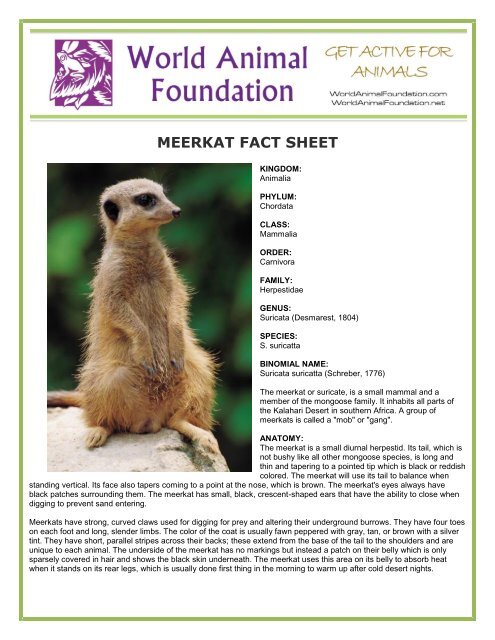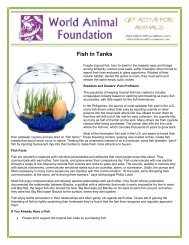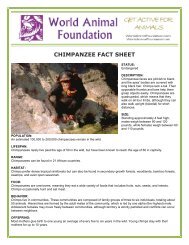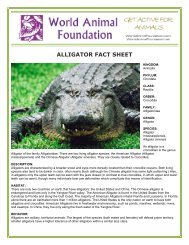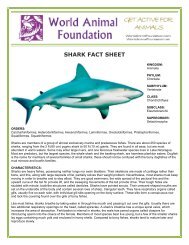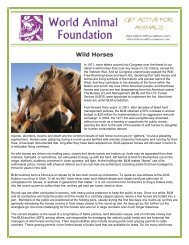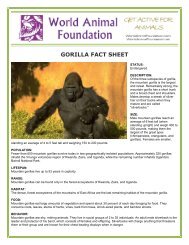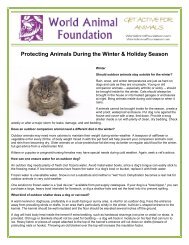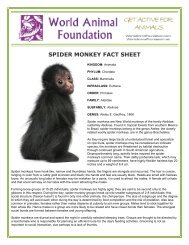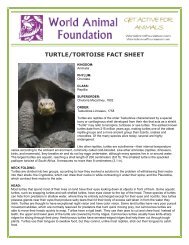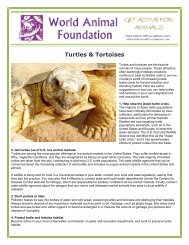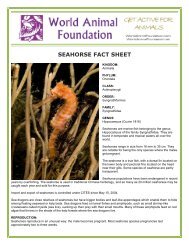MEERKAT FACT SHEET - World Animal Foundation
MEERKAT FACT SHEET - World Animal Foundation
MEERKAT FACT SHEET - World Animal Foundation
You also want an ePaper? Increase the reach of your titles
YUMPU automatically turns print PDFs into web optimized ePapers that Google loves.
<strong>MEERKAT</strong> <strong>FACT</strong> <strong>SHEET</strong><br />
KINGDOM:<br />
<strong>Animal</strong>ia<br />
PHYLUM:<br />
Chordata<br />
CLASS:<br />
Mammalia<br />
ORDER:<br />
Carnivora<br />
FAMILY:<br />
Herpestidae<br />
GENUS:<br />
Suricata (Desmarest, 1804)<br />
SPECIES:<br />
S. suricatta<br />
BINOMIAL NAME:<br />
Suricata suricatta (Schreber, 1776)<br />
The meerkat or suricate, is a small mammal and a<br />
member of the mongoose family. It inhabits all parts of<br />
the Kalahari Desert in southern Africa. A group of<br />
meerkats is called a "mob" or "gang".<br />
ANATOMY:<br />
The meerkat is a small diurnal herpestid. Its tail, which is<br />
not bushy like all other mongoose species, is long and<br />
thin and tapering to a pointed tip which is black or reddish<br />
colored. The meerkat will use its tail to balance when<br />
standing vertical. Its face also tapers coming to a point at the nose, which is brown. The meerkat's eyes always have<br />
black patches surrounding them. The meerkat has small, black, crescent-shaped ears that have the ability to close when<br />
digging to prevent sand entering.<br />
Meerkats have strong, curved claws used for digging for prey and altering their underground burrows. They have four toes<br />
on each foot and long, slender limbs. The color of the coat is usually fawn peppered with gray, tan, or brown with a silver<br />
tint. They have short, parallel stripes across their backs; these extend from the base of the tail to the shoulders and are<br />
unique to each animal. The underside of the meerkat has no markings but instead a patch on their belly which is only<br />
sparsely covered in hair and shows the black skin underneath. The meerkat uses this area on its belly to absorb heat<br />
when it stands on its rear legs, which is usually done first thing in the morning to warm up after cold desert nights.
The meerkat's diet is mainly insectivorous, but they will also consume lizards, snakes, spiders, plants, eggs and small<br />
mammals. Like all mongoose species, the meerkat has developed an immunity to many venoms. This allows them to eat<br />
scorpions (including the stinger) and some snakes without fear of illness, poison or death. They have no fat stores so if<br />
they don't forage for food every day they will die.<br />
REPRODUCTION:<br />
Meerkats become sexually mature at about one year of age and have, on average, three young per litter. The wild<br />
meerkat will have up to three litters a year. Meerkats are iteroparous and can reproduce any time of the year but most<br />
births occur in the warmer seasons. Reports show that there is no precopulatory display; the male will fight with the<br />
female until she submits to him and copulation will begin. Gestation lasts approximately eleven weeks and the young are<br />
born within the underground burrow and are altricial. The young's ears will open at about 10 days of age, and eyes at 10-<br />
14 days; they are weaned between 49 and 63 days. They will not come above ground until at least three weeks of age<br />
and will stay with babysitters near the burrow. It will be another week or so until they join the adults on a foraging party.<br />
Usually, the alpha pair reserve the right to mate and will normally kill any young not their own to ensure that their offspring<br />
has the best chance of survival. They may also exile or kill the mothers of the offending offspring.<br />
BEHAVIOR:<br />
Meerkats are burrowing animals, living in large underground networks with multiple entrances which they leave only<br />
during the day. They are very social, living in colonies of up to forty. <strong>Animal</strong>s from within the same group will often groom<br />
each other to strengthen social bonds. The alpha pair will often scent mark subordinates of the group to express their<br />
authority, and such actions are usually followed by the subordinates licking the faces of, and grooming, the alphas. These<br />
actions are also usually practiced when members of the group are reunited after a short period apart. Most meerkats<br />
within the same group are all siblings and offspring of the alpha pair.<br />
Meerkats demonstrate altruistic behavior within their colonies; one or more meerkats will stand sentry (lookout) while<br />
other members are foraging or playing in order to warn them of approaching dangers. When a predator is spotted, the<br />
meerkat performing as sentry will give a warning bark, and all other members of the gang will run and hide in one of the<br />
many bolt holes the meerkats will have spread across their territory. The sentry meerkat will be the first to reappear from<br />
the burrow and search for predators, constantly barking to keep the others underground. If there is no threat, the sentry<br />
meerkat will stop barking and the others will be safe to emerge. Meerkats will also babysit any young that may be in the<br />
group. Females that have never produced offspring of their own will often lactate to feed the alpha pair's young while the<br />
dominant female is away with the rest of the group. They will also protect the young from any threat, often endangering<br />
their own lives to do so. On warning of a danger, the babysitter will either take the young underground to safety and be<br />
prepared to defend them if the danger is able to follow, or collect all young together and lie on top of them if retreating<br />
underground is not possible.<br />
Meerkats have been known to engage in social activities, including what appear to be wrestling matches and foot races.<br />
Despite their normally-altruistic behavior, meerkats have contradicted this by killing young members of their societies.<br />
Subordinate meerkats have been seen killing the offspring of more senior members in order to advance their own<br />
offsprings' positions.<br />
VOCALIZATION:<br />
Meerkat calls have recently been noted to carry an element of meaning, with specific calls alerting to the approach of<br />
snakes, birds of prey, or other predators. How these calls work is not clear. They are a demonstration that meaning is not<br />
solely the domain of human language.<br />
More than one field researcher has reported witnessing meerkats in some sort of singing ceremony they compared with<br />
yodelling.<br />
HABITAT:<br />
Meerkats live in southern parts of Africa which is dominated by the Kalahari desert. The Kalahari desert has little rainfall<br />
and an arid climate with open plains. It spreads across the Southern part of Africa covering over one million square miles<br />
and is 10 times the size of Great Britain. The land is covered by a porous or soft sand that in many places is bright orange<br />
color.


